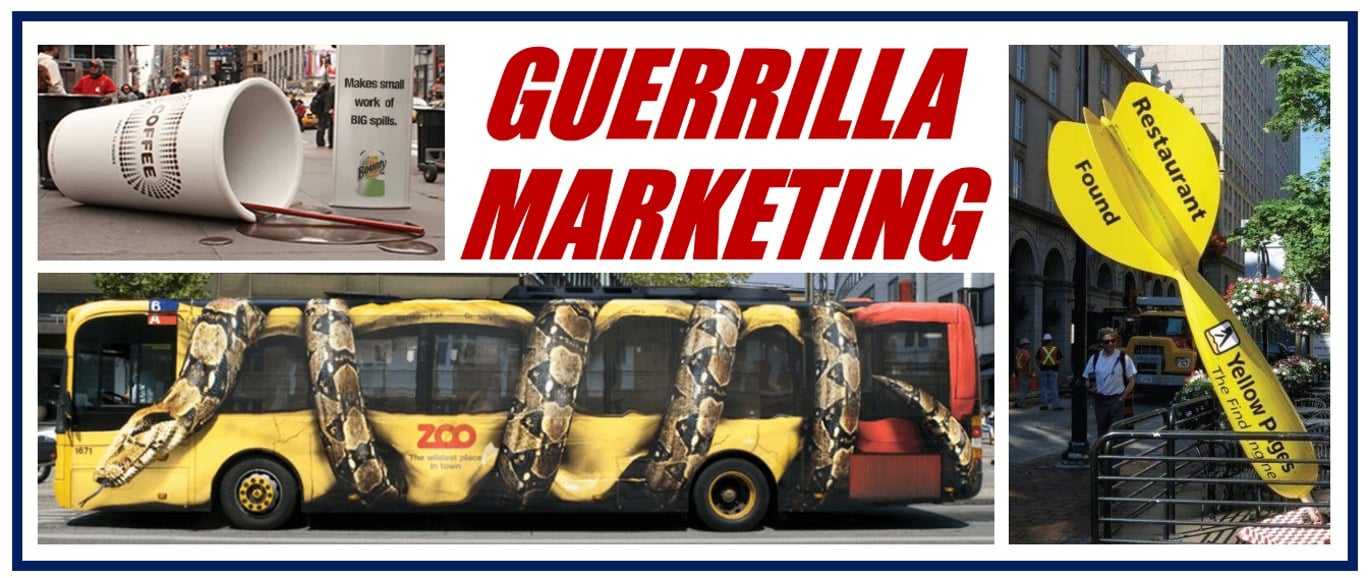If you use surprise or unconventional marketing methods to promote your product, you are involved in Guerrilla Marketing. The term refers to a (usually) cheap, non-traditional advertising approach that uses public art installations, graffiti, treasure hunts, and other imaginative presentation techniques.

This type of marketing is characterized by its ingenuity, creativity, and ability to generate a buzz. Word-of-mouth marketing is often a part of or result of guerrilla marketing.
Dictionary.com has the following definition of guerrilla marketing:
“A low-cost, nontraditional advertising strategy that uses imaginative presentation, as graffiti or public art installations, and interactive experiences, as stunts or treasure hunts.”
‘Guerrilla’ comes from Spanish
The word ‘guerrilla’ is Spanish for ‘little war.’ The term was first used to describe the strategies and tactics of small, insurgent rebels to fight larger and more established military forces.
Professionals will tell you that guerrilla marketing strategies involve finding creative and innovative ways to stand out in today’s fiercely competitive marketplace and grab consumers’ attention.
Guerrilla Marketing – non-traditional media channels
If you opt for non-traditional media channels when promoting a product or service, you have adopted one of the key principles of guerrilla marketing.
Instead of just relying on TV, radio, print, and Internet ads, you might use viral videos, street art, and flash mobs to get your message across. A flash mob is a group of people who suddenly assemble in public to perform something unusual and entertaining before rapidly dispersing. The whole event does not typically last more than a few minutes, hence the word ‘flash’.
With guerrilla marketing tactics, you can reach consumers in unexpected ways. You can also create a sense of excitement and novelty around your brand.
Customer experience focus
Guerrilla marketing also focuses on the customer experience. The aim is to create engaging and memorable experiences that leave a lasting impression on consumers, and especially prospects. A prospect is a consumer who you believe could well turn into a paying customer.
This may involve setting up a scavenger or treasure hunt, hosting a flash sale, or erecting a pop-up shop in a busy public space. In all cases, the aim is to engage consumers with a brand in exciting and new ways.
An example of Guerrilla Marketing
The energy drink Red Bull is a master of guerrilla marketing. In its Red Bull Stratos campaign, the Austrian skydiver Felix Baumgartner broke the sound barrier when he jumped from a balloon at the edge of space.
Baumgartner’s achievement generated huge media coverage and a massive social media buzz. In all this coverage, Red Bull became known as the brand that pushes boundaries and takes risks.
A risky strategy
Because of its unusual, eccentric, and bizarre nature, guerrilla marketing is not without risks. If you do not know how to pull it off, you could end up damaging your brand.
It is also important to make sure that any bizarre or eccentric marketing strategy is legal. It must not violate people’s rights and privacy.
Ethical Considerations in Guerrilla Marketing
While guerrilla marketing is praised for its innovative and cost-effective approach, it’s essential to address the ethical implications associated with Marketing campaigns are often executed in public spaces without formal permissions, blurring the lines between advertising and public art or disruption.
This can sometimes lead to backlash, especially if the campaign is viewed as intrusive or inappropriate in its context.
Furthermore, the surprise element inherent to guerrilla marketing means that consumers don’t always have the choice to opt out of the experience. This can be problematic, especially in an era where consumer consent is paramount.
Brands must be careful not to overstep boundaries and ensure that their guerrilla tactics align with the values and preferences of their target audience. An understanding of cultural nuances and local regulations is crucial to avoid unintended controversies.
If you’re not careful, a well-planned surprise campaign intended to impress and turn heads can end up turning consumers against your brand.
Examples of campaigns that backfired
- Streakers at a N. Zealand vs. Australia rugby match
In New Zealand in 2002, Vodafone organized for streakers (nude runners) to run onto the field during a rugby match between the All Blacks and Australia. The streakers had the Vodafone logo painted onto their backs. This upset many fans and led to criticism of the brand.
- Sony’s PSP Graffiti Ads (2005)
Sony spray-painted images of kids playing with PSP devices onto walls in several major US cities. Although Sony described the advertisements as art, locals and officials did not agree. They called them nothing more than vandalism. PSP stands for PlayStation Portable.
Video explanation
This Marketing Business Network explains what guerrilla marketing is in a way that’s simple and easy to understand:
